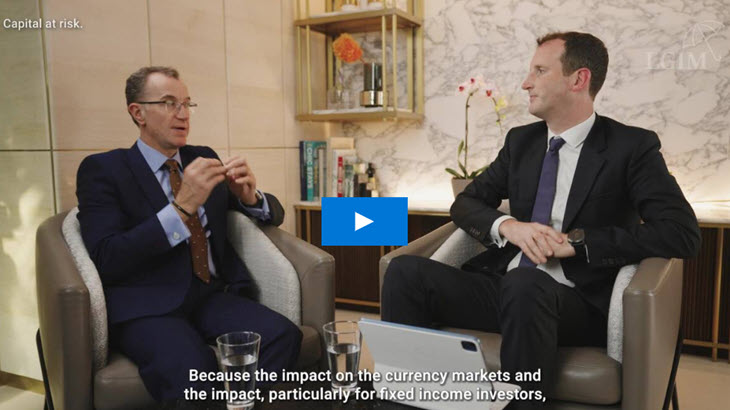Q1 2024 Asset Allocation Outlook: Asymmetry in motion
Ambiguous near-term economic conditions and heightened geopolitical risk make adaptability more important than ever.

The following is an extract from our Q1 Asset Allocation outlook.
“When the facts change, I change my mind. What do you do, sir?” ― John Maynard Keynes.
2023 was a difficult year for economists, ourselves included, as a much-heralded recession failed to materialise. Following this no-show, we must now contemplate three options:
- Embrace randomness: Accept the unpredictability inherent in economic forecasting, which in turn supports a diversified approach.
- Join the consensus: Conform to the majority view, risking the loss of individual insight.
- Persist with the recession forecast: Stick to the view even when the facts change. If none of these makes sense, there is a fourth way: adapting our outlook.
If you know our Head of Economics Tim Drayson, you will know that the first two options don’t appeal to him, although he acknowledges there are times when joining the consensus makes sense.
But as the facts have changed – most notably the Federal Reserve (Fed)’s pivot and greater than expected fiscal spending – the outlook should adapt. Tim has revised our forecast; while we still believe the lagged effects of this year’s rate hikes could precipitate a US recession in 2024, this is no longer our base case economic forecast. Instead, we expect a period of weak US economic growth, and should recession occur, it will be milder than we previously anticipated.
Our resolution for 2024 is to approach economic forecasting with a lighter touch, focusing on balancing risks rather than precise predictions.
Better, but still not good
With our pessimism toned down, does that mean we have become optimists? No. We believe that our change in outlook is symptomatic of a broader change in the consensus that is playing out. We expect to remain below consensus forecasts, albeit with a smaller gap than before.
Those with bearish 2024 views (formed in October/November for year-ahead outlooks) have been pushed by events into upgrading. Estimates of the earnings profile priced into markets are consistent with earnings expectations in the US that are even more optimistic than the 10-12% bottom-up consensus. If we correct for standard overoptimism, we get to a 7% level of earnings growth.
The overwhelming base case is for those expectations to be disappointed, not exceeded. Moreover, if we put either our roadmap or consensus in our profit modelling, we would end up at single-digit negative earnings growth. This is because the delta, or change, in nominal growth is the most important driver.
Balancing probabilities
We think the rally in markets in November and December shows that US recession risk is still underappreciated by investors. We now feel the global economy faces an asymmetric outlook in 2024.
Our recession indicators continue to flash red. This is not an environment for strong growth, even if recession is avoided. We may have upgraded our central case, but none of that has changed the previously identified late-cycle pressures stemming from low unemployment, tight labour markets, slowing nominal GDP growth, a weak housing market and tight bank lending conditions.
In summary, we are less worried about recession as a central case, but it is different from resetting the clock to early/mid cycle. The range of the scenarios we consider indicate a negative return on risk assets. This is due to a higher recession probability than normal and a lower expected return should the cycle continue like it did in 2023.
So, even if recession is avoided, we do not expect a strong economic environment or market performance. High valuations in equities, and a significant amount of rate cuts already priced, also limit potential for a major rally, and we note that the market has become marginally more expensive over the past quarter.
Beneath the surface, there is a regional split between the US (expensive) and the rest of the world (neutral to cheap). This disparity between the US and the rest of the world is true even after adjusting for sectoral differences and mega-cap stocks, though the gap is smaller once these effects are removed.
Elephants in the room
Multiple geopolitical risks and a busy election calendar, meanwhile, create volatility and uncertainty.
The most important political event of 2024 is the US elections. Polls1 suggest a Trump win in the upcoming election is a distinct possibility, albeit not inevitable.
A Trump win could result in trade disputes, tariffs, more tax cuts and further US isolationism. All of these are, in principle, inflationary and could drive yields up.
Tax cuts could be good for stock markets, but that depends where we are in the cycle by the end of 2024 when a potential new president takes his or her seat. If inflation is low and growth is below trend, tax cuts should cause equities to rally; if inflation is above target, we could see rates up significantly, the Fed turning much more hawkish to rein in inflation and equities potentially anticipating a hard landing.
Outside the US, geopolitical risk scenarios on our radar include an escalation of the Ukraine war with NATO mobilising, intensified hostilities in the Middle East, a Chinese naval blockade of Taiwan, and increased tensions on the Korean peninsula.
We believe that embracing uncertainty is key to success against this complex backdrop. We need to prepare for different scenarios, not just our cautious central outlook.
The above is an extract from our Q1 Asset Allocation outlook.
Key risks
The value of an investment and any income taken from it is not guaranteed and can go down as well as up, you may not get back the amount you originally invested. Past performance is no guarantee of future results.
Whilst LGIM has integrated Environmental, Social, and Governance (ESG) considerations into its investment decision-making and stewardship practices, this does not guarantee the achievement of responsible investing goals within funds that do not include specific ESG goals within their objectives.
The risks associated with each fund or investment strategy should be read and understood before making any investment decisions. Further information on the risks of investing in this fund is available in the prospectus at. http://www.lgim.com/fundcentre




